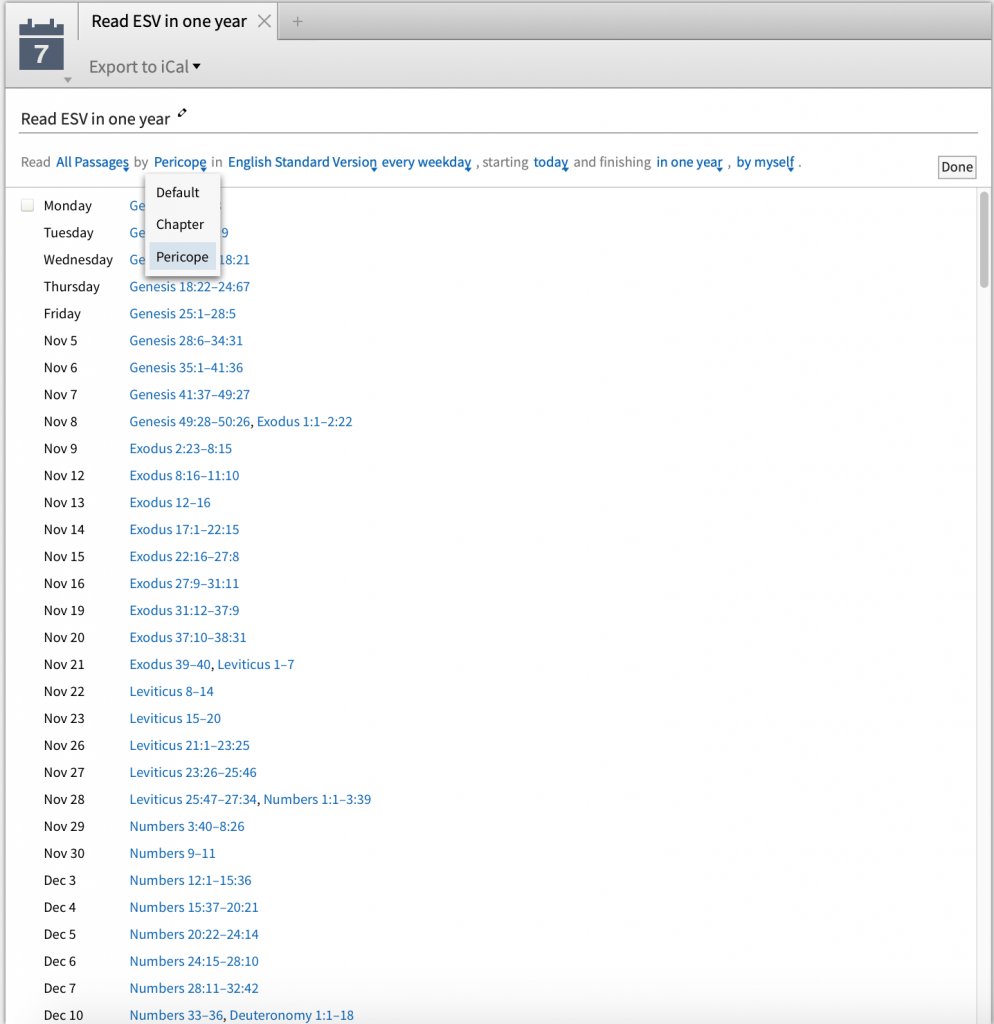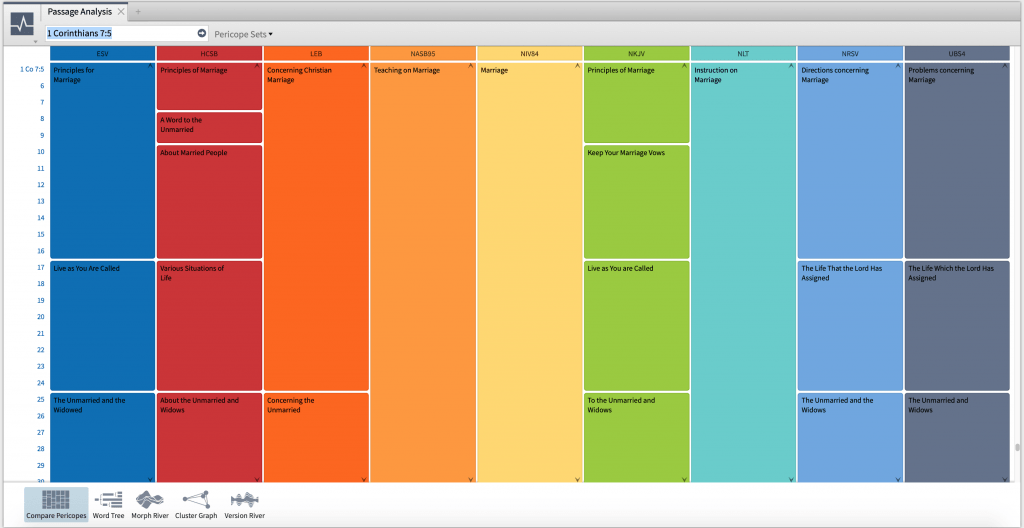Pop quiz! What’s the name of the headings in your Bible? Don’t know? Well, you’re not alone. If you’re like me, you probably just called them headings. I know I didn’t know any better. But, they do have a name. These headings are called “pericopes,” which is not to be confused with the word periscope (like on a submarine).
I was first introduced to the correct terminology of pericopes nearly a decade ago when my pastor used the word from the pulpit. At the time, he was preaching through the gospels and reached John 7:53-8:11, which is the woman caught in adultery. The scholarly name for this Scripture passage is the “Pericope de Adultera.” In this sermon my pastor went into great detail about the name, pericopes, and the passage itself. That day I learned more about pericopes than I ever wanted to.
Since that time, I’ve made an effort to educate others about the term and how they can incorporate these headings into their Bible study. And that is the goal of this Bible study tip. We’re going to explain what a pericope is, with a brief look at its history, and then look at several ways we can use them in our Bible study.
What is a Pericope?
At its simplest, a pericope is a division or section of text. It comes from the Greek word perikopē. It is a compound word from the Greek words peri (around) and kopē (cutting). The Greek essentially means to cut around. From this we get the idea of a pericope being a “section” or portion of something larger.
While generally used in literature, this terminology is almost exclusively relegated to the realm of biblical studies. So, to give it a more biblical definition, a pericope is a portion of Scripture. According to pericope.net, they referred to larger paragraphs that were read in the church. Over time it has become a way for Bible scholars and students to break up the text into manageable portions for study.
This process of dividing the text made its way into the Bible itself, giving us the headings we have today.
Why Do We Have Pericopes?
The next question is this: why do we have pericope headings in our Bibles? Well, because they’re useful. Like other tools in the Bible, such as chapter and verse divisions, pericopes help us speedily navigate Scripture so we can find the passage we’re looking for. That is its primary purpose.
Pericopes also serve to us what a given passage is about. Therefore, not only can we know where a verse is, we can know what it’s about before we start reading.
They’re there to help. Pericopes are a guide to digging into God’s Word.
Pericopes are a guide to digging into God’s Word. Share on XAre They Part of the Bible?
There is one important fact we need to know about pericope headings: they are not an inspired part of the Bible. Much like our beloved cross-references, these too are additions from publishers.
This does not make pericopes a bad thing. On the contrary, they are a helpful tool for both Bible reading and study. We just need to know we cannot attribute the same level of trust to them as we do Scripture itself.
Are All Pericopes the Same?
No, not all pericope headings are the same. Each Bible publisher creates their own set of pericope headings and divisions for the biblical text. Sure, a lot of publishers will use the same divisions in places, and even the same titles, but as a whole, from Genesis to Revelation, each pericope set is unique. If we open up the ESV, its headings will be different than what is found in the CSB, NIV, or NASB.
Differences in pericopes is a good thing, and that is something we can use to our advantage in our Bible study.
How to Use Pericope Headings in Your Bible Study
Even though pericopes are only headings, there are multiple ways we can incorporate them into our Bible study. Let’s look at a few ways they can prove useful for study and general Bible reading.
Quick Outlines/Surveys
In a previous Bible study tip we talked about how to do a Bible survey study. One goal within that Bible study method is creating a unique outline of the text. We can quickly build such an outline with the use of pericope headings. These Bible headings point out the major sections within each chapter, so we can see the book’s structure at a glance. Thus, these pericope headings can become the sub-points that fill out our outline.
Easy Reading Divisions
Much like they do for outlining the text, pericope headings make us aware of divisions within the biblical text while reading. Without these headings it would be difficult to know where to stop reading or where one major thought ends and another begins. Instead, we would have to search on our own for visual cues within the text to know when to stop.
This is exactly what happens with something like a Reader’s Bible. It removes both verse numbers and pericope headings, and sometimes even the chapter numbers. This format allows us to read the Bible as literature; but, in the process, makes it difficult to know when to stop. But, even most literature has chapters and scenes to mark divisions of text. So, it’s not wrong to expect the Bible to do the same.
Bible headings are useful for this very reason. If we want to open up our Bible and read, we can know when we’re at a good place to stop and pick it up next time.
Pericope headings are also useful with Bible reading plans. For example, in Logos Bible software I like to create my own reading plans. During the creation process I tell it to use the headings to break up the text into daily readings. This keeps me from having awkward stops in my daily Bible reading.
Scan for Passages
Concordances are great when we know a word or two in a verse but don’t remember where it’s located. In a similar fashion, pericope headings can assist us in the process of finding the passage we’re looking for. For example, the story of David & Goliath is somewhere in 1 Samuel. Instead of using a concordance, we can open our Bible to 1 Samuel and flip through the chapters until we see a heading referencing David & Goliath, which happens to be 1 Samuel 17.
Pericope headings are helpful when we know the general area where the verse or passage is located. Once in the general vicinity, all we have to do is flip and browse the headings until we find our passage.
Pericope headings are helpful for finding a passage when you know its general vicinity. Share on XUses in Bible Software
As we stated earlier, each Bible publisher has their own set of pericope headings they use in their Bibles. This means there is variation between Bibles, whether it be the title, passage, or a combination of both. Knowing this, we can compare Bible headings to get a more comprehensive look at a book’s structure.
When I begin studying a new book of the Bible, this is one of the steps I perform as part of my survey study. I want to see how different Bibles break up the book and individual chapters.
Logos Bible software makes this effortless with their Passage Analysis tool. Within this tool is a view that compares multiple pericope headings. Select your translations and the software takes care of the rest. It lays out the Bible verses in the left column, with a column for each pericope set. This view lets we see a pericope’s title and where it ends in comparison to other pericope sets. Now we can view the nuances of each set, which can be helpful when doing your Bible survey.
This tool and others are perfect for visualizing the differences between pericopes. Sometimes looking at multiple Bibles laid out on a desk or dining room table doesn’t cut it, and you need the visual aids. Bible software does for us.
Create Your Own
Again, as stated before, pericope headings are not part of the Bible, nor are they inspired. With that in mind, we shouldn’t be afraid to outline a book of the Bible (like in a survey study) and create our own pericope headings. We can create them as we study a book of the Bible or as we’re reading.
One thing I like about the HEAR Journaling method from Replicate Ministries is how it asks us to give a title to our daily readings. The process of giving our passage a title is essentially creating a Bible heading. As we read, we should write our own titles in our notes; and, if we’re bold, write them in our Bibles next to the other headings.
The practice of creating our own pericope headings creates triggers that increase our ability to remember what a given passage is about. Don’t just rely on the headings in the Bible, be creative and come up with your own.
What Will Be the Next Pericope You Study?
Now that you know a pericope is nothing more than a Bible heading and division of Scripture, there’s only one thing left to do: start using them in your Bible study! It doesn’t matter if you’re using them for outlines, as reading markers, or creating your own, make them a regular part of your Bible study.
So, what’s the next pericope of Scripture you’re going to study? Leave a comment below and let me know.
Weekly Study Prompts
This week, meditate and journal on the following passages:
- Monday – 2 Corinthians 9-10
- Tuesday – 2 Corinthians 11-13
- Wednesday – Romans 1-2; Acts 20:1-3
- Thursday – Romans 3-4
- Friday – Romans 5-6
- Memory Verses: Romans 5:1; 2 Corinthians 10:4
Free Bible Study eBook
Click the button below to get a free copy of our "Bible Study Blitz" ebook that will give you 5 tips to enhance your Bible study.







